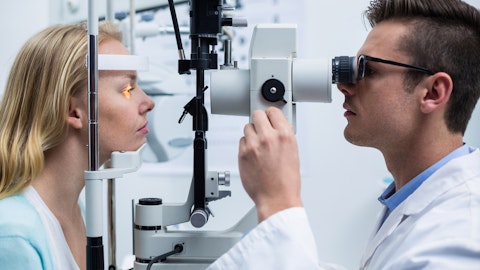Frank Stokes: Yes. So, as I think we shared, we think the market there may maybe a little bit bigger than we had anticipated when we first were looking at TissueCypher. The right population for us to think about there is the surveillance endoscopy. So patients that are having a surveillance endoscopy or an upper GI endoscopy for Barrett’s Esophagus. And we’ve got really good data now that says about 417,000 or so of those a year, which is a higher number than we thought. Now the second piece of that — so that’s that’s the total pool, but we’re not appropriate — well, it would not be useful to physicians to test on patients who have that procedure, and then come back from pathology with high-grade dysplasia. And that’s that’s about 5%or 6% of those cases are high-grade dysplasia.
And the reason is just that, at that point, that’s going to be concerning enough that the physician is going to want to go ahead to ablate that patient. So you can kind of take — if you want to use round numbers — take 90% of the 417,000, and that’s the that’s the group we think we are appropriate for each year. That’s more of a — you’d want to think of that as more of an incidents type measure, because there are certainly more patients than that that have Barrett’s, but if they’re not having that surveillance endoscopy, then they’re not candidates, or we wouldn’t be wouldn’t be able to test. That’s the tissue we test is the is the pinch biopsy tissue from the surveillance endoscopy.
Operator: Thank you. Next question comes from Sung Ji Nam of Scotiabank.
Sung Ji Nam: Hey, thanks for taking the questions and congrats on the year. Maybe starting out with SCC, just kind of — DecisionDx-SCC — you talked about the overlap with the DecisionDx-melanoma, in terms of I think, over 70% of the orders are coming in for both. There’s overlap. I’m just kind of curious, given that you’ve had SCC commercially available now over a year, just curious kind of what you’re seeing from the same-store sales, if you will, standpoint, just based on, you know, with the physicians and their experiences with SCC? Kind of if you’re seeing any trends in terms of reordering patterns and things like that?
Derek Maetzold: Hi, Sung Ji, Derek here. We haven’t disclosed that, following today or on the press release, as far as our call. We do expect, and did expect early on, that clinicians who diagnose skin cancer of cutaneous melanoma will also be the same medically-oriented dermatologists who will diagnose the skin cancer squamous cell carcinoma. So we assume there’d be significant kind of overlap from a perspective of will this dermatology customer be seeing these kinds of patients, and two, it was also our belief that if these clinicians who adopted or are using our DecisionDx-melanoma tests appropriately for medical necessary purposes, that they would be more open to, I guess, seeing how use of our test for squamous cell carcinoma would go ahead and fill what we see as a significant unmet need.
Sort of what I think we’re seeing is the actual experience of our expectation, which is good by the way. But I think the other aspect here is to say, why? And the why part to me is that in patients with high-risk squamous cell carcinoma, there’s there’s this pinch point here. And as Frank mentioned earlier, 99% of patients that we test today are eligible under guidelines for adjuvant radiation therapy or ART. And adjuvant radiation therapy has been recognized as an effective treatment for high-risk patients for, I think, at least two or three decades. We’ve published data recently presented last summer to the Medicare contractors, demonstrating that not only can our tests identify patients who are in this high-risk category, who will have a low risk of progression, or a high risk of progression compared to the population base estimate, but also able to go ahead and demonstrate that we can find people who are eligible for ART, who actually have a very, very low likelihood of getting any kind of response.
And the benefit to that, of course, is avoidance of radiation complications. The therapy itself and at least based upon a publication back in January of this year, the use of our tests in these ART-eligible patients to help rule out unnecessary intervention probably saves the Medicare trust fund north of $900 million, which is a great way to improve healthcare outcomes by reducing complications with no benefit. And of course, costs extraction.
Sung Ji Nam: Got it. And then just on the follow-up on the TissueCypher, obviously great to see that product know outperforming your expectations. Just kind of curious, looking back, what do you think are the key drivers of the outperformance? Other than you know, that market being actually bigger than you had initially estimated?
Derek Maetzold: Well, you took away one of the drivers, but okay. I think that what we saw during diligence prior to the acquisition was a fairly rapid sort of head nodding, I guess I would call it, from the guest neurologists that we contacted during diligence about market interest, and what’s the clinical unmet need really like. And I think to a tee, there is good recognition saying, hey, we have this FDA-approved device, radiofrequency ablation tool or tools, that we use in people with high risk at — on pathology, high-risk on pathology. And this tool is showing to be very, very effective at really stopping progression to esophageal cancer in its tracks. The problem is that we also recognize that because we don’t ARV with people with non-dysplastic Barrett’s Esophagus disease, which is that ends up being the larger population of people actually progress to cancer, because we’re just surveying them.



